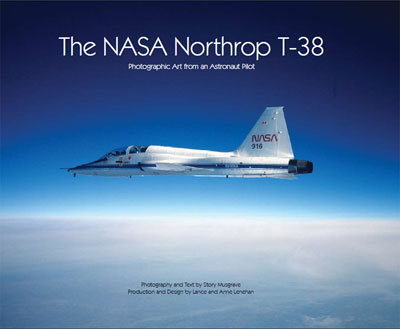Review: The NASA Northrop T-38by Eric R. Hedman
|
| If you are expecting the traditional book that goes through the history of an aircraft and how it was used, specific detailed stories with a smattering of pictures, this is not it. |
Most space buffs will recognize the T-38 jet as the aircraft the flight crews of NASA’s space missions use to fly from Houston to Kennedy Space Center a few days before their missions. The T-38 is used for much more than an expensive transport aircraft. The aircraft is used to keep the flying skills of the crews up to date. In addition, flying rigorous training missions puts the crews in situations that, while not exactly like flying the shuttle, require them to work together in a coordinated manner where concentration and teamwork are of utmost importance. It is a real world scenario—one that can’t be fully duplicated in a simulator—that translates to how crews conduct themselves on a mission.
If you are expecting the traditional book that goes through the history of an aircraft and how it was used, specific detailed stories with a smattering of pictures, this is not it. There are comments by Story Musgrave throughout the book that put the pictures in context. This book consists primarily of mostly incredibly beautiful photographs of the NASA T-38 trainer in flight, on the ground, and in the hangars for maintenance. It is clear from the pictures in this book that Story Musgrave looks for beauty in the world. Most people are too busy doing their jobs to stop and smell the roses. Story Musgrave doesn’t ever seem to stop, but he smells the roses along the way nonetheless.
When most people think of NASA, I’m sure that the T-38 isn’t the first thing that comes to mind. There are thousands of other pieces of the tapestry that creates the totality of NASA. For NASA the iconic images are of the Space Shuttle, the Vehicle Assembly Building, the Saturn 5 rocket, the Lunar Excursion Module, Neil Armstrong standing on the Moon, and the “Blue Marble” photo of Earth from lunar orbit, among others. Those images and feats would not be possible without all the lesser known components of NASA. History is made up of these components and the anonymous people behind the scenes that make great things possible. This book documents one of the key components that has helped make many of NASA’s missions successful.
When I was seven or eight years old I had a toy F-100 jet fighter. I used to run around holding it like it was flying and imagining myself at the controls. The graceful T-38 aircraft looks like it can do many of the maneuvers my imagination conceived of so many decades ago. I had my toy airplane doing loops and turns that sometime defied the laws of physics. The pictures of the T-38 reminded me of those moments in my youth when any dream was still a possibility.
| This book documents one of the key components that has helped make many of NASA’s missions successful. |
I would recommend this book to anyone who appreciates creative photography, flying, the beauty of dazzling images, or simply has an appreciation of the significance of this nearly fifty-year-old aircraft. One extraordinary picture near the end of the book—a line of T-38s sitting on a tarmac framed by a complete rainbow—is an example of the photographic artistry of Story Musgrave. Great photography is part luck at being in the right place at the right time, but also having a constantly aware eye for what constitutes a great picture. This book is a summary of what my former colleague who never brought a camera with him to the four corners of the Earth should have done. It gives the rest of us a vicarious view into the world of NASA pilot astronauts.
Today almost everyone at least has a cell phone camera to snap the images of key memories. Don’t be so obsessed with work and the day’s events to not notice the roses that are always nearby if you only pay attention. Shortly after my colleague told me of his regrets about not having a camera I ran out and bought a Minolta X-700 that has accompanied me on trips to some of the corners of the world. When I’m old and retired not only will I be looking at the pictures to remind me of what I’ve done and where I’ve been. I will hopefully occasionally look through The NASA Northrop T-38 and think of running around as a small child with my old toy F-100 imagining the future.
